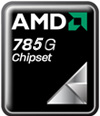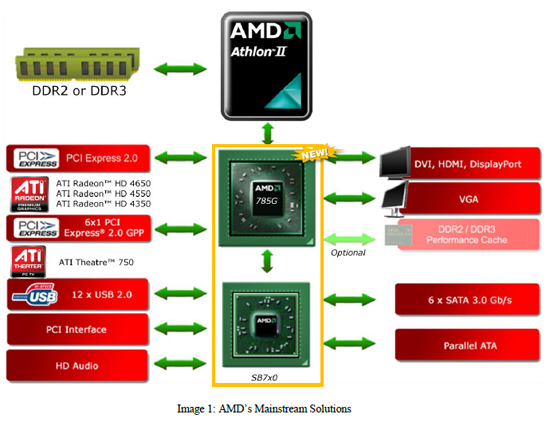AMD is back in the mainstream. Only a short while ago
saw the launch of its completely redesigned Athlon II processor line, a value-oriented CPU,
while its ATI 40nm Radeon
HD 4770 videocard has tuned out
to be one of the best value-for-money mainstream graphics cards. AMD's latest mainstream integrated graphics chipset is the
AMD 785G and Radeon HD
4200 IGP. The AMD 785G and its Radeon
HD 4200 are the first with DirectX 10.1 compliance for Microsoft
Windows 7 operating system, and include enhanced features like ATI Stream application acceleration
and improved Universal Video Decoding 2.
MSI 's 785GM-E65 motherboard is built around the AMD 785G and SB710 chipsets, and features 128MB integrated
DDR3 SidePort memory. MSI has adapted the AMD 785G chipset into a micro-ATX form
factor, an ideal size for small home and office computers, and best of
all Home Theatre PCs.
The MSI 785GM-E65 is a socket AM3 motherboard, which means
it's compatible with AMD's newest processors like the Phenom
II X4 955 Black Edition and the Athlon II X2
250 . AMD will gradually transition
all of its desktop processors to socket AM3 over the next few years, so investing
now could save you a bit of hassle later on.
|
Feedback?
What do you think of this review?
Help make PCSTATS better, leave your comments here. |
While upgrading to
DDR3 has been a daunting prospect in the past, memory prices have dropped
dramatically and modules are basically at parity with DDR2 RAM now.
The 785GM-E65 will accommodate up to 16GB of DDR3-800/1066/1333MHz memory, however
the real firepower comes with the Radeon HD 4200 integrated graphics
processor. This IGP is the next evolution of the Radeon HD 3200, adding support
for DirectX 10.1 and Shader Model 4.1 graphics.
The guts of the Radeon HD 4200 IGP are made up of 40 stream processors that
run at a core clock of 500MHz, so while this is still an IGP (expect integrated
graphics performance, not a miracle), AMD claims it can handle some "mainstream" gaming. To this end
the MSI 785GM-E65 has also been equipped with 128MB of DDR3-1333 Sideport memory
as a performance cache, and on top of that the GPU can be overclocked too.
PCSTATS will be putting those claims to the test a little later on in this
review.
 |
|
MSI 785GM-E65 Motherboard |
|


|
|
|
|
INCLUDES: User's Manual,
Driver CD, (2) SATA cables, (1) SATA-to-Molex power cable, I/O
Shield, IDE cable. |

|
|
Chipsets: AMD 785G (128MB) / AMD
SB710
CPU Support: AMD socket
AM3
Memory Type: Dual Channel
DDR3-800/1066/1333
Videocard Support: (1) PCI Express x16 2.0
Integrated
Graphics: Yes (HDMI,
Analog, DVI) | |
| |
The launch of the AMD 785G chipset also includes an
update for ATI Stream. ATI Stream is a initiative to bring GPU hardware
acceleration to graphics-heavy desktop applications like Adobe Acrobat Reader,
Microsoft Silverlight and Cyberlink Espresso. In these applications the Radeon
HD 4200 IGP will take over for the CPU, and should result in somewhat faster
performance in applications that can take advantage of the extra compute power.
ATI Stream has some very exciting potential, and PCSTATS will be putting it to
some real-world tests in this review.

The graphics capabilities of the AMD 785G are the real
selling point in our books. Just like the AMD 690G/780G before it, we're spoiled
with a trifecta of video outputs - HDMI, DVI and VGA.
Dual controllers mean it's easy to get dual monitors
running with the 785GM-E65 too. The digital HDMI output is fully HDCP compliant
and can carry audio as well as video, so it's no problem getting a HDTV hooked
up for some big-screen computing.
The Radeon HD 4200 is HDMI 1.3 compliant, so it also
supports higher bandwidth and greater colour depth for future video standards.
For real FPS 3D gaming a videocard is what you'll need.
An integrated graphics processor cannot compete with a decent mainstream
videocards, and in that regard the MSI 785GM-E65 motherboard features a PCI
Express 2.0 x16 slot which is likely to see almost immediate use. The board can
be run for standard desktop applications on the Radeon HD 4200 quite well - a
videocard isn't needed to do office work, or even watch an HD movie. The 785G's
got you covered in those respects!
The 785GM-E65 also has an additional PCI Express
x1 slot and a pair of legacy PCI slots for legacy peripheral expansion.
Storage on the MSI 785GM-E65 is handled by the AMD SB710
southbridge, which has support for five SATA 3Gb/s ports and an eSATA port for
external storage. The SATA connections can be operated in RAID 0, 1, 0+1 and
JBOD modes. There's also an IDE and floppy connector.
 On the I/O panel of the MSI 785GM-E65
motherboard we find six USB 2.0 ports, an IEEE 1394a firewire port, a PS/2
keyboard/mouse combo port, gigabit LAN, S/PDIF optical output, eigh channel
stereo output, and the aforementioned eSATA, HDMI, DVI and VGA ports.
Considering this is a micro-ATX motherboard, having such a fully-featured suite
of inputs and outputs is impressive, and definitely adds to its value-quotient.
On the I/O panel of the MSI 785GM-E65
motherboard we find six USB 2.0 ports, an IEEE 1394a firewire port, a PS/2
keyboard/mouse combo port, gigabit LAN, S/PDIF optical output, eigh channel
stereo output, and the aforementioned eSATA, HDMI, DVI and VGA ports.
Considering this is a micro-ATX motherboard, having such a fully-featured suite
of inputs and outputs is impressive, and definitely adds to its value-quotient.
The MSI 785GM-E65 motherboard is surprisingly
affordable, retailing on average for $95 CDN, ($90 USD, £55 GBP). When paired together with
AMD's economical 3.0GHz Athlon II X2 250 processor and a Radeon HD 4770 videocard it's possible to put together
a versatile PC that could work as a gaming box, HTPC or home/office productivity
computer for under $500 .
How will the MSI 785GM-E65 and AMD's new 785G chipset
compare to other IGP solutions like Intel's G45 Express or NVIDIA's nForce series ?
Follow along as PCSTATS explores the AMD 785G chipset
and examines the MSI 785GM-E65 from corner to corner.
 Introducing the AMD 785G
chipset / SB710 Southbridge
Introducing the AMD 785G
chipset / SB710 Southbridge
The AMD
785G chipset brings support to the Dragon platform for DirectX 10.1, making it
fully Microsoft Windows 7 compliant. It's high definition hardware-base decoding
accelerates certain kinds of video transcoding and graphics-intensive
applications; a new tool to the world of IGPs. AMD's 785G is an all-around
incremental improvement to the AMD 780G chipset, the previous darling of the IGP
world.
The AMD
785G chipset also continues AMD's strategy of having cross-compatiblity support
for a huge range of processors, including the new Athlon II 250 microprocessor.
Since the AMD 785G chipset leaves memory control up to the CPU, it can be used
with both socket AM2 and socket AM2+/AM3 processors and support DDR2 or DDR3
memory.
The
centerpiece of the AMD 785 chipset is the Radeon HD 4200 IGP. This new graphics
core is very similar to the Radeon HD 3200 that powered the AMD 780G. Both IGPs
are built on a 55nm process, have 40 stream processors, and are made up of ~205
million transistors. Performance of the 500MHz Radeon HD 4200 IGP should be
largely similar to AMD's previous IGPs, with the key changes being support for
DirectX 10.1 and Shader Model 4.1.
Should
you want to use a stand alone videocard the AMD 785G chipset supports a PCI
Express 2.0 x16 slot, and can be used in Hybrid Crossfire mode with selected ATI
Radeon graphics cards such as the Radeon HD 3450. In ideal situations, this will
double the performance of the Radeon HD 4200 IGP... although doubling an IGP's
3D performance still isn't comparable to the power of a dedicated graphics
card.


